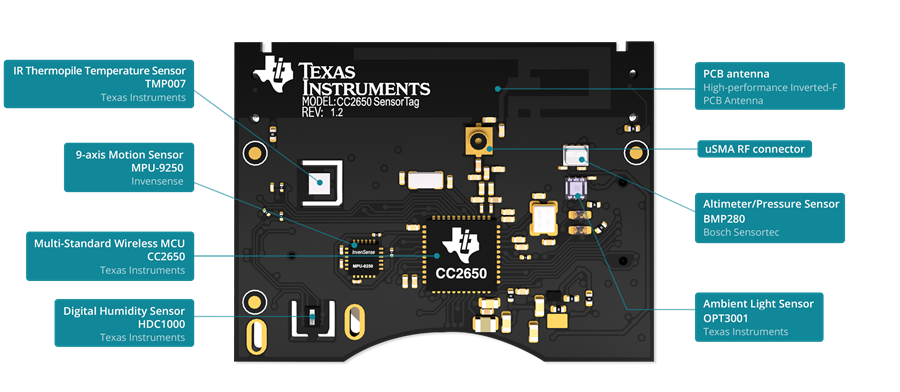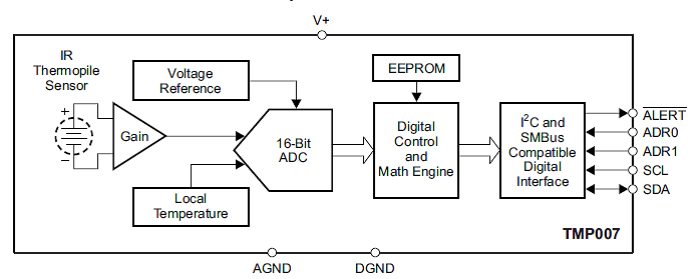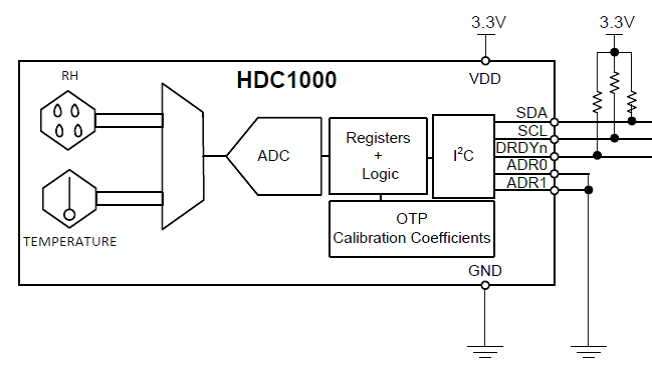SSZTCK7 june 2015 HDC1000 , OPT3001
Wikipedia defines the Internet of Things (IoT) as “the network of physical objects or ‘things’ embedded with electronics, software, sensors and connectivity to enable it to achieve greater value and service by exchanging data with the manufacturer, operator and/or other connected devices”. This is the SensorTag story. TI has made available its next-generation wireless connectivity development platform allowing quick and easy prototyping of IoT devices. The SensorTag is the first provider that combines sensor data with secure cloud connectivity in less than three minutes. This blog provides a quick overview of the three low-power TI sensors embedded within the SensorTag shown below in Figure 1.
 Figure 1 SensorTag Teardown
Figure 1 SensorTag TeardownAs the world becomes more connected with the widespread use of handheld devices and the ability to store data in the cloud, having the capability to sense the world around will be even more prevalent than today. Humidity sensors, accelerometers, gyroscopes, magnetometers, thermometers, gas sensors, altimeters, cameras, light sensors, and many other types of sensors make it easy to measure the environment and make decisions based on the information. A major aspect of this is to upload the data onto the web making wireless connectivity an essential part of the IoT.
Ambient light sensors are useful in many applications such as detecting light to adjust the lighting on your PC display therefore prolonging the useful life of the display itself. IR sensors make it possible to measure temperature without physically touching the target object. Think of a pot of hot soup, for example. Why measure humidity? Ever felt an electrostatic discharge (ESD) on your finger? It’s not fun! In low humidity, ESD events are more likely to happen. ESD can build up in clothes, on your body, on metal surfaces, and many other places so keeping humidity in check will help prevent ESD strikes to occur. I’ll summarize each sensor type and the benefits they provide next.
OPT3001 – Ambient Light Sensor
The OPT3001 is a single-chip lux meter with precision human eye spectral response and unrivaled IR rejection allowing the sensor to measure the intensity of visible light regardless of the light source. The state-of-the-art OPT3001 is designed for systems where the user experience is impacted by variable lighting. Its precision spectral response dramatically reduces the error across all lighting conditions, making it an ideal replacement for less-than-optimal photodiodes, photoresistors, or other ambient light sensors that do not match up to human eye responses. Figure 2 below shows the OPT3001 sensor maximum efficiency at a 555-nm wavelength.
 Figure 2 Photopic Luminous Efficiency
Figure 2 Photopic Luminous EfficiencyAside from the stellar performance in matching the human eye response, the OPT3001 has many other attributes that make it suitable for many ambient light sensing applications. Table 1 below summarizes them.
| Features | Benefits |
|---|---|
| Excellent IR rejection | Rejects > 99% of IR matching human eye response |
| Lux sensitivity from 0.01 (less than a candlelight) to 83,000 (direct sunlight) with effective 23-bit resolution | Wide dynamic range maintains a high resolution even at low light conditions |
| Measurements can be continuous or single-shot | Flexibility in choosing amount of data needed |
| Operates down to 1.6V and draws only 2.5uA (max) | Extremely low power for extended battery life or energy harvesting applications |
| Digital control and interrupt system | Autonomous operation allows the processor to sleep while the sensor searches for appropriate wake-up events to report |
| I2C- and SMBus-compatible | Bus available in many MCUs |
TMP007 – IR Temperature Sensor
The TMP007 is a complete IR thermopile sensor system-on-chip (SoC) that includes the sensing element, signal conditioning, an analog-to-digital converter (ADC), and math engine to calculate object and die temperatures. The device measures the temperature of an object without physically touching the object by absorbing the infrared energy emitted from the object. The built-in thermopile produces internally a digitized voltage representation of the temperature, and provides this and the die temperature to the integrated math engine, which then computes the corresponding object temperature. Figure 3 below summarizes the top-level description of the TMP007.
 Figure 3 Simplified Schematic
Figure 3 Simplified SchematicTable 2 summarizes some of the inherent benefits to using the TMP007 in an IR-based temperature measurement system.
| Features | Benefits |
|---|---|
| Integrated thermopile with an analog front end, 16-bit ADC, integrated local temperature sensor, and voltage reference | Single-chip solution for contactless temperature measurements |
| Integrated math engine with non-volatile memory | Built-in computation power to provide object temperature directly via I2C; stores calibration and thermal transient coefficients |
| Ultra-small 1.9mm x 1.9mm WCSP package | Thin profile and footprint enables use in space-constrained industrial applications; 85% smaller & 63% thinner than other solutions |
| Industry’s lowest power consumption | Enhances battery life |
| Digital control and interrupt system | Autonomous operation allows the processor to sleep while the sensor searches for appropriate wake-up events to report |
| I2C- and SMBus-compatible | Bus available in many MCUs and allows up to 8 devices on a single bus |
HDC1000 – Humidity Sensor
The HDC1000 is a digital humidity sensor with an integrated temperature sensor that provides excellent measurement accuracy at very low power. The device measures relative humidity based on a novel capacitive sensor technology which is placed on the ball side of the device making it a robust solution against environmental contaminants such as dirt and dust.
Figure 4 shows the HDC1000 block diagram revealing the device not only has a built-in ADC, but also carries a temperature sensor (±0.2°C accuracy at 30°C) on board. The humidity/temperature combination is useful in many applications including HVAC systems, thermostats, and other mobile applications.
 Figure 4 Simplified Schematic
Figure 4 Simplified SchematicThe HDC1000 provides the following unmatched benefits:
-
Lowest current:
- 1.2 uA avg. for humidity and temp @ 1sps
- 820 nA avg. for humidity only @ 1sps
-
Smallest size:
- Tiny 2mm x 1.6mm footprint
-
High accuracy:
- ± 3% relative humidity accuracy
- ±0.2°C temperature accuracy
Thanks for reading.